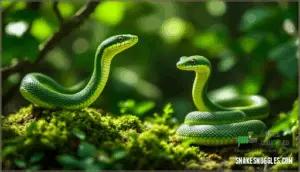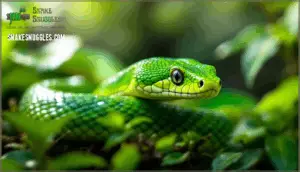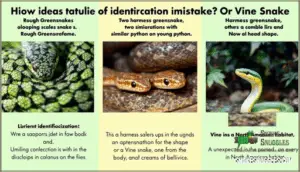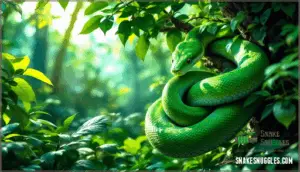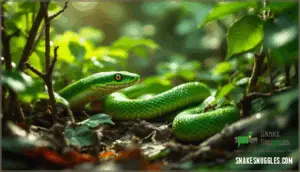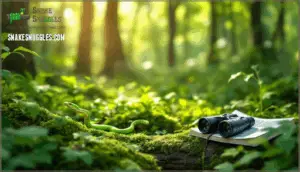This site is supported by our readers. We may earn a commission, at no cost to you, if you purchase through links.
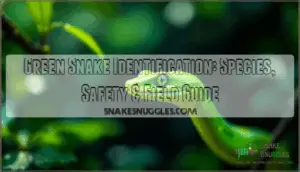
From the docile Rough Greensnake of southeastern woodlands to the lethally venomous Green Mamba of African forests, green-colored serpents span a significant range of species with vastly different behaviors and risks. Learning to recognize key features—scale texture, head shape, eye placement, and behavioral cues—transforms uncertainty into confidence, whether you’re hiking, gardening, or simply sharing space with wildlife.
Table Of Contents
- Key Takeaways
- Common Green Snake Species Worldwide
- Key Identification Features of Green Snakes
- Habitat, Distribution, and Behavior
- Conservation Status and Threats
- Safe Observation and Interaction Tips
- Frequently Asked Questions (FAQs)
- Is there a green snake that is poisonous?
- How do you identify a rough green snake?
- What kind of snake is solid green?
- How do green snakes camouflage themselves in their environment?
- What are the differences between smooth and rough green snakes?
- Can green snakes be kept as pets, and what are the risks?
- What time of year are green snakes most active?
- Can green snakes change color throughout their lives?
- How long do green snakes typically live in captivity?
- Do green snakes make good pets for beginners?
- Conclusion
Key Takeaways
- Green snakes range from harmless insect-eaters like North America’s Rough and Smooth Greensnakes to lethally venomous species like Africa’s Green Mamba, making accurate identification critical for safety during field encounters.
- Key identification features include scale texture (keeled versus smooth), head shape (triangular with brow ridges suggests venom apparatus), pupil shape (vertical slits indicate venomous species), and ventral coloration, which often provides more reliable distinctions than dorsal color alone.
- The Smooth Greensnake faces significant conservation threats from habitat fragmentation and pesticide use, earning "Species of Greatest Conservation Need" status in multiple states despite its global "Least Concern" rating.
- Safe observation requires maintaining at least six feet of distance from any green snake, avoiding handling wild specimens entirely, and understanding that most green snakes rely on camouflage and retreat rather than aggression when threatened.
Common Green Snake Species Worldwide
When you’re out in the field or browsing through reptile guides, you’ll quickly notice that "green snake" isn’t just one species—it’s a whole spectrum of serpents spread across the globe. From harmless North American natives to venomous African tree-dwellers, each species brings its own set of identifying traits and behaviors.
Let’s walk through seven of the most commonly encountered green snakes you’re likely to hear about or spot in the wild.
Rough Greensnake (Opheodrys Aestivus)
The Rough Greensnake (Opheodrys aestivus) offers a fascinating glimpse into arboreal behavior within Southeastern habitats. This snake identification becomes easier when you recognize its keeled scales and striking camouflage effectiveness among branches and foliage, where it hunts its insect diet. Some green snakes, like the Eastern Green Mamba, are highly venomous.
- Adults reach 35–82 cm usually, though some specimens extend to 116 cm
- Keeled scales create a ridged texture, distinguishing it from its smooth-scaled cousin
- Bright green dorsal coloration with yellow bellies boosts camouflage effectiveness in vegetation
- Non-venomous nature and arboreal lifestyle make encounters with humans relatively rare
Smooth Greensnake (Opheodrys Vernalis)
Smooth Greensnake (Opheodrys vernalis) differs sharply from its rough cousin—you’ll notice its smooth scales immediately when picking one up. This slender snake reaches 36–66 cm and inhabits beaver meadows, overgrown fields, and pastures where its insect diet (spiders, crickets, and beetles) thrives. The Rough Green Snake, in contrast, is known for its arboreal lifestyle.
| Feature | Description |
|---|---|
| Scale Texture | Completely smooth, not keeled |
| Coloration | Bright green dorsally; white to off-white ventrally |
| Temperament | Gentle behavior; rarely bites when touched |
Habitat preferences lean toward moist grasslands rather than dense forest canopy.
Its conservation status is concerning—designated S3 (Species of Greatest Conservation Need)—because pesticide use and habitat loss from intensive agriculture threaten populations. Smooth Greensnake identification becomes critical for targeted surveys evaluating fungal disease prevalence and ecological threats.
Asian Vine Snake (Ahaetulla Spp.)
Asian vine snake (Ahaetulla spp.) stands out in Southeast Asia through striking arboreal adaptations—you’ll spot its horizontally keyed pupils and needle-slim profile weaving through foliage like a living vine. Camouflage techniques make this snake nearly invisible against green leaves.
Its mildly toxic rear-fanged venom immobilizes lizards, frogs, and small birds. Females practice egg laying in concealed, moist tree hollows.
Snake identification hinges on recognizing that elongated snout and binocular vision, critical for depth perception during strikes.
Boomslang (Dispholidus Typus)
Moving from Southeast Asia to Sub-Saharan Africa, you’ll encounter the boomslang (Dispholidus typus)—an arboreal predator whose venom ranks among the most potent hemotoxins in any rear-fanged snake.
Snake identification becomes critical here: this venomous snake shows shy behavior, retreating into foliage rather than striking.
Females practice egg laying in hidden nests throughout their African habitat, where camouflage and patience define their hunting strategy.
Emerald Tree Boa (Corallus Caninus)
In South America’s canopy, the emerald tree boa (Corallus caninus) demonstrates a specialized arboreal lifestyle perfectly adapted to its Amazon habitat. This non-venomous constrictor relies on powerful constriction methods to subdue prey, distinguishing it from many other green snakes you’ll encounter during snake identification.
- Live birth sets this species apart—females deliver fully formed young instead of laying eggs
- Dietary habits focus on birds, bats, and small mammals captured in the trees
- Heat-sensing pits along the jaw enable nighttime hunting in dense rainforest vegetation
- Coiled resting posture over branches resembles the green tree python but evolved independently
Green Tree Python (Morelia Viridis)
Native to New Guinea, Indonesia, and Australia’s Cape York Peninsula, the green tree python (Morelia viridis) showcases striking arboreal adaptation within rainforests.
This snake identification guide emphasizes morphology—stocky build, distinctive white vertebral markings, and heat-sensing labial pits.
Diet includes small mammals, birds, and reptiles hunted nocturnally.
Habitat loss threatens wild populations, though captivity breeding aids conservation.
Its snake appearance mirrors the emerald tree boa through convergent evolution, not shared ancestry.
Green Mamba (Dendroaspis Spp.)
Highly venomous arboreal snakes within the genus Dendroaspis, green mambas inhabit coastal forests and wooded savannas across eastern, southern, and western Africa. Mamba venom toxicity causes rapid neurotoxic effects, making mamba bite symptoms—respiratory paralysis, ptosis, ataxia—medical emergencies requiring immediate antivenom.
Mamba habitat loss escalates mamba conservation status concerns, though mamba hunting behavior targeting birds and small mammals persists where forest canopy remains intact.
- Eastern green mamba (D. angusticeps) dwells in coastal thickets from Kenya to South Africa, while western green mamba (D. viridis) occupies West African rainforests
- Snake identification guide criteria include slender build, coffin-shaped head, and uniform bright green dorsal scales distinguishing these green snake species from non-venomous arboreal counterparts
- Unlike terrestrial venomous snakes, arboreal snakes like mambas exhibit shy, retreat-first behavior unless cornered, emphasizing habitat preservation over direct human conflict
Key Identification Features of Green Snakes
Identifying green snakes accurately requires paying attention to several physical traits that separate one species from another. You’ll need to look at body structure, coloring, head shape, and behavioral clues to make a confident identification.
Let’s break down the key features you should examine in the field.
Body Shape and Scale Texture
When you’re trying to pin down which green snake you’ve spotted, your first clues are literally skin-deep—body shape and scale texture tell a surprisingly detailed story before you even get close. Slender species like Rough Greensnakes have keeled rough scales that feel textured, while Smooth Greensnakes feature smooth scales that glide under your fingertips.
Body proportions vary dramatically—arboreal species tend toward elongated, whip-like builds for shape camouflage among branches, whereas terrestrial forms appear more stout. These texture variations and appearance differences become your primary snake identification and characteristics tools in the field.
Color Patterns and Ventral Markings
Look past that striking emerald exterior and you’ll find the real clincher—ventral markings and subtle color variations separate species faster than any other feature once you flip a green snake over.
Rough Greensnakes show yellowish belly scales, while Smooth Greensnakes display white or off-white coloration underneath. These appearance differences in ventral markings provide reliable identification clues, especially when dorsal coloration looks similar across species—your key to confident field identification.
Head Shape and Eye Characteristics
If you’ve sorted belly colors and still feel uncertain, the head and eyes often seal the deal—shape, size, and pupil structure reveal whether you’re holding a harmless insect-eater or facing a venomous striker. Snake anatomy speaks volumes once you know what to look for:
- Pupil Shape: Round pupils generally indicate non-venomous species like Rough and Smooth Greensnakes, while vertical slits signal venomous snakes such as Boomslangs and Green Mambas.
- Head Scales and Brow Ridge: Triangular heads with prominent brow ridges often mean venom apparatus; slender, sleek heads suggest harmless species.
- Eye Size and Loreal Pits: Large eyes aid arboreal hunters in depth perception, while heat-sensing loreal pits appear only in certain venomous groups—key reptile identification characteristics for appearance-based snake characteristics assessment.
Venomous Vs. Non-Venomous Traits
Beyond pinpointing head and eye features, you need clear-cut markers that separate venomous snake behavior from harmless species. Venom delivery systems define the divide: bright green snake species like Boomslangs possess rear fangs and hemotoxic venom composition, while Rough Greensnakes lack venom apparatus entirely.
Scale morphology—keeled versus smooth—pairs with behavioral differences: venomous snakes strike defensively, non-venomous ones freeze or flee.
Bite symptoms range from localized swelling in mildly venomous species to severe hemorrhaging in mambas, making accurate identification life-saving during field encounters.
Common Identification Mistakes
Even experienced observers mix up harmless green snakes with venomous look-alikes, and those errors stem from relying on color alone instead of checking scale texture, head shape, and behavioral cues together. Here’s where confusion strikes hardest:
- Scale misidentification: Confusing keeled Rough Greensnake characteristics with smooth-scaled species creates false confidence in identification.
- Juvenile confusion: Young pythons and boas display color variations that mimic adult Smooth Greensnake characteristics before their patterns develop.
- Range overlap: Habitat assumptions fail when distributions shift, placing Asian vine snakes where you’d expect local species.
Habitat, Distribution, and Behavior
Understanding where green snakes live and how they behave helps you identify them accurately in the field. Each species has adapted to specific environments, from treetops to ground cover, and their habits reflect these niches.
Let’s explore the key aspects of their habitat, distribution, and behavior.
Arboreal and Terrestrial Habitats
Green snakes have carved out two distinct lifestyles in the wild—some spend their days weaving through treetops while others hug the ground, and understanding where each species feels at home will sharpen your identification skills in the field.
Arboreal species like Asian Vine Snakes and Emerald Tree Boas thrive in forests with dense canopy structure, weaving through branches in microclimates rich with prey. Terrestrial species prefer ground cover in wetlands and grasslands. Habitat fragmentation threatens both lifestyles, creating habitat overlap where you’ll need sharp eyes to distinguish neighbors.
| Lifestyle | Preferred Snake Habitats |
|---|---|
| Arboreal | Dense forests, rainforest canopies |
| Arboreal | Coastal thickets, wooded savannas |
| Terrestrial | Overgrown fields, beaver meadows |
| Terrestrial | Grasslands with bushes, vine tangles |
Geographic Ranges of Major Species
Understanding where each snake species roams will help you narrow down identifications quickly. Climate influence and biogeographic barriers create natural boundaries that keep most green snake species from overlapping in range. Here’s where you’ll find the major players:
- Rough Greensnake: Southeastern United States from southern New Jersey to Florida, west to central Texas and Kansas, plus extreme northeastern Mexico
- Smooth Greensnake: Northern North America from New England through the Great Lakes to central Montana, extending into southern Canada
- Asian Vine Snake: South and Southeast Asia including India, Sri Lanka, Myanmar, Thailand, Malaysia, and Indonesia up to 2,000 meters elevation
- Boomslang: Sub-Saharan Africa from Senegal to Somalia, south to South Africa, inhabiting karoo scrublands and savannas at 1,200–2,400 meters
- Emerald Tree Boa: Northern South America across the Guianas and Amazon Basin from northwestern Colombia to southern Brazil below 1,000 meters
Snake distribution patterns show habitat specificity. The two North American Opheodrys species demonstrate classic range overlap avoidance, with Rough Greensnakes dominating the Southeast while Smooth Greensnakes claim northern territories. Introduced species remain rare among green snakes, though habitat fragmentation continues shifting traditional boundaries.
Camouflage and Defensive Behaviors
When threatened, green snakes don’t rely on aggression—they vanish into their surroundings or freeze like living branches, making predators question what they’re even looking at. Camouflage effectiveness peaks when they align their green backs vertically against stems, mimicking plant structure.
Rough Greensnakes demonstrate behavioral adaptations by remaining motionless for extended periods, while Asian Vine Snakes sway gently, mimicking wind-blown foliage—a defensive display that improves predator avoidance without confrontation.
Hunting and Feeding Habits
After perfecting their disappearing act, green snakes shift focus to their next survival skill—finding food without being seen by predators or prey. Their hunting strategies reflect dietary adaptations tied to body type and habitat:
- Insect specialists like Rough and Smooth Greensnakes patrol vegetation for invertebrates—grasshoppers, crickets, and spiders—using slow, deliberate movements.
- Ambush hunters including Asian Vine Snakes detect prey through motion, striking lizards and frogs with precision.
- Constrictors such as Emerald Tree Boas rely on constriction methods to subdue birds and mammals, while venomous species use venom strategically.
Hunting frequency varies: smaller snakes require near-daily insect intake.
Mating and Reproductive Strategies
Once breeding season arrives, green snakes demonstrate reproductive strategies as diverse as their hunting methods—ranging from egg-laying to live birth, with each approach shaped by evolutionary pressures and environmental demands. Most species are oviparous, laying eggs in concealed nests—Asian Vine Snakes and Eastern Green Mambas deposit clutches in moist, hidden locations where hatchlings emerge fully independent.
Emerald Tree Boas break this pattern through viviparity, giving birth to live young without parental care.
Mating rituals vary by species, but successful reproduction depends on favorable environmental conditions.
Conservation Status and Threats
Not all green snakes are thriving in the wild. Some species face serious pressures from habitat destruction, pesticide exposure, and other human-driven threats.
Let’s look at the conservation challenges these snakes encounter and what’s being done to protect them.
Species of Greatest Conservation Need
You’ll find the smooth greensnake (Opheodrys vernalis) listed as a Species of Greatest Conservation Need across many northeastern states’ Wildlife Action Plans. Connecticut has gone further, designating it as a species of special concern under their Endangered Species Act, making collection or harm illegal. Michigan flags it as a "Species of Special Concern" due to severe population drops in many areas.
Though globally rated "Least Concern" by the IUCN, regional declines tell a different story—some areas near New York have lost populations entirely.
Impact of Habitat Loss and Pesticides
Habitat loss and pesticide effects hit smooth greensnakes harder than most reptiles. Urban sprawl and agricultural expansion fragment critical habitats, isolating populations and reducing genetic diversity—western populations in Montana show particularly low heterozygosity from this fragmentation.
Pesticides kill snakes directly and devastate their insect prey; at least 75.9% of tested ecological parameters show negative impacts on soil invertebrates.
These combined threats to species create conservation needs that demand immediate habitat protection.
Conservation Efforts and Management Strategies
Protecting green snakes requires targeted habitat management that considers the specific ecological needs of these insect-dependent reptiles. Effective conservation efforts and management strategies include:
- Habitat preservation through Wildlife Action Plan designations
- Pesticide reduction within and adjacent to occupied territories
- Targeted surveys to map population distributions
- Disease monitoring for emerging fungal infections
- Public awareness campaigns promoting coexistence
These conservation status improvements depend on your support for habitat protection initiatives.
Survey Methods and Research Needs
To improve green snake monitoring, you’ll need survey methods that account for detection probability challenges. Visual encounter surveys and cover board arrays remain standard survey techniques, but detection rates often fall below 30% even during best survey timing in spring and early summer.
Occupancy modeling approaches now outperform simple counts for cryptic species.
Future research priorities include eDNA technology for non-invasive detection and improved understanding of habitat connectivity, especially for isolated populations where genetic studies reveal limited gene flow.
Safe Observation and Interaction Tips
Observing green snakes in their natural habitat can be rewarding, but it requires respect and caution. Whether you encounter a harmless Rough Greensnake or a venomous species like the Boomslang, knowing how to keep yourself safe while supporting conservation efforts makes all the difference.
Here’s what you need to know about safe observation, bite prevention, emergency response, and ways you can help protect these extraordinary reptiles in your own backyard.
How to Safely Observe Green Snakes
When you’re watching green snakes in the wild, patience and a respectful distance will reveal far more than any hurried approach ever could. Observe behavior from at least six feet away, using binoculars if needed.
Here’s what to keep in mind:
- Respect habitat by staying on trails and avoiding disturbance to vegetation
- Practice photo ethics—no flash photography or repositioning snakes for better angles
- Conduct visual surveys quietly, noting snake behavior and appearance for natural history records
Avoid picking up wild snakes entirely.
Avoiding Green Snake Bites
Most green snakes won’t bite unless you grab them or corner them, so your best defense is simply keeping your hands to yourself. Smooth and Rough Greensnakes are especially gentle and never bite, relying instead on camouflage for defense.
Venomous species like mambas require safe distancing—always maintain at least six feet. Understanding snake behavior helps dispel greensnake myths and keeps both you and the snake safe during encounters.
First Aid for Snake Encounters
If a bite does happen—venomous or not—stay calm, remove jewelry near the bite, and get to a hospital without trying to catch or identify the snake.
While you wait for medical assistance, follow these steps:
- Keep the bitten area below heart level and avoid movement to slow venom spread.
- Clean the wound gently with soap and water if available, but don’t apply ice or tourniquets.
- Watch for bite symptoms like swelling, pain, or breathing difficulty, which help doctors assess antivenom access needs.
Promoting Snake Conservation in Your Area
You can make a real difference for snakes right in your backyard by creating safe spaces and spreading awareness among neighbors who might otherwise reach for a shovel.
Promote habitat preservation through responsible landscaping that reduces pesticides, protects local ecology, and provides wildlife corridors.
Support research initiatives and community education programs that address conservation threats while fostering appreciation for these essential creatures in your environment.
Frequently Asked Questions (FAQs)
Is there a green snake that is poisonous?
Don’t judge a book by its cover—several green snakes pack serious venom. The boomslang and Eastern green mamba deliver potent toxicity through hemotoxic and neurotoxic venom, respectively, while the Asian vine snake possesses milder defensive compounds, making toxicity identification important when encountering these snakes.
How do you identify a rough green snake?
The rough greensnake has keeled dorsal scales that create a slightly rough texture, while its solid bright green dorsal coloration and yellowish-white belly help distinguish it from similar species in its habitat.
What kind of snake is solid green?
Several snake species display solid bright green coloring, including the Smooth Greensnake and Rough Greensnake in North America. Both feature solid green bodies with yellowish to white bellies, making them masters of camouflage in vegetation where they hunt insects and spiders.
How do green snakes camouflage themselves in their environment?
Like a chameleon at a costume party, green snakes don’t change outfits—they’re born wearing the perfect disguise. Their bright green snake color mirrors vegetation in their habitat, allowing predator avoidance through behavioral camouflage, remaining motionless when threatened, achieving complete habitat matching year-round.
Green snakes are born wearing the perfect disguise, their bright coloration mirroring vegetation for complete habitat camouflage year-round
What are the differences between smooth and rough green snakes?
The primary distinction lies in scale texture: Smooth Greensnakes have completely smooth scales, while Rough green snakes possess keeled scales that feel textured.
Both species share similar habitat preferences in vegetation, though the divided anal plate helps separate them during identification.
Can green snakes be kept as pets, and what are the risks?
Some snake species adapt to captivity challenges better than others, but green snakes face ethical considerations and legal restrictions.
Responsible ownership requires understanding snake habitat needs, diet specifics, and health risks associated with particular snake species.
What time of year are green snakes most active?
Seasonal activity patterns mirror nature’s heartbeat, with temperature influence driving when you’ll encounter these serpents.
Green snakes are most active during warm months—spring through early fall—when daylight hours extend, prey availability peaks, and mating seasons unfold before hibernation habits begin.
Can green snakes change color throughout their lives?
Color change triggers vary among species, but most green snakes don’t shift hues dramatically through their lives. Genetic factors lock in their emerald tones, though shedding influence and environmental adaptation can slightly alter brightness or intensity temporarily.
How long do green snakes typically live in captivity?
Captivity lifespan factors vary widely among species, but most green snakes live five to twelve years under proper care.
Species longevity comparison shows smooth greensnakes averaging six years, while emerald tree boas can surpass fifteen with excellent veterinary care and diets.
Do green snakes make good pets for beginners?
Green snakes present challenges for beginners due to their specialized care requirements and sensitive temperament concerns. Their diet demands live insects, precise enclosure setup with humidity control, and ethical considerations about captive snake reproduction versus supporting snake natural history through observation in their native snake habitat.
Conclusion
A hiker in Georgia once mistook a Rough Greensnake for a young Green Mamba—a case of misidentification that could have ended in panic, though the snake was completely harmless. This confusion underscores why green snake identification matters: accurate field skills separate needless fear from legitimate caution.
By learning scale texture, head shape, and regional distribution, you transform uncertain encounters into opportunities for safe observation. The next time emerald scales catch your eye, you’ll know exactly what you’re seeing—and how to respond with confidence and respect.
- https://mnfi.anr.msu.edu/species/description/11517/Opheodrys-vernalis
- https://srelherp.uga.edu/snakes/rough-green-snake/
- https://ejournal.amikompurwokerto.ac.id/index.php/telematika/article/view/2992
- https://en.wikipedia.org/wiki/Smooth_green_snake
- http://www.basic.ncsu.edu/segap/datazip/reports/SppReport_rRGSN.pdf

